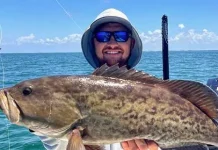An unusual fatality calls for reassessment of hazards & risks.
Last fall a very large 1,100 foot container ship was arriving the Port of New York/New Jersey in heavy weather with about 40 knot winds, 13 foot swells and 60 oF seawater temperatures. As the vessel maneuvered at about 10 knots to make a lee in preparation to embark a ship’s pilot via a side shell access port, it was hit by heavy seas that forced the side shell hatch door open resulting in flooding of the embarkation space, sweeping one crewman out to sea and injuring another. At the time of the casualty, the vessel was on a west-northwesterly course with seas on the vessel’s starboard quarter.
 The ship’s Boatswain and Ordinary Seaman (OS) were manning the port side shell access port and pilot embarkation space behind a hydraulically operated bi-fold hatch door, pictured below, and were preparing for the pilot’s arrival. The port was located forward of the house and approximately 13 feet above the waterline. The Boatswain and OS were unable to monitor the seas from their position behind the hatch door. As the two crewmembers were in the process of opening the door, seas unexpectedly struck and violently forced it open, flooding the space.
The ship’s Boatswain and Ordinary Seaman (OS) were manning the port side shell access port and pilot embarkation space behind a hydraulically operated bi-fold hatch door, pictured below, and were preparing for the pilot’s arrival. The port was located forward of the house and approximately 13 feet above the waterline. The Boatswain and OS were unable to monitor the seas from their position behind the hatch door. As the two crewmembers were in the process of opening the door, seas unexpectedly struck and violently forced it open, flooding the space.
The OS was not wearing a harness or safety line nor a personal flotation device; he was subsequently swept out to sea. The Boatswain was forced onto the deck whereby the pilot ladder fell on him, fracturing his leg. The side shell door also suffered structural damage during the incident, again echoing the dangers of and power of the sea. Coast Guard Sector New York launched an extensive search and rescue mission that was terminated with no success after a 28 hour search. The OS was lost and was presumed dead.
This casualty reiterates the dangers of personnel exchanges at sea, especially in heavy weather conditions. Even though the side shell hatch door was located on the port side and was being brought onto the vessel’s lee, the crew’s inability to observe and assess the sea conditions combined with the ship’s roll and sea state presented significant risks.
The Coast Guard strongly recommends owners and operators of deep draft vessels:
- Review vessel Safety Management Systems, procedural manuals and guidance that relate to pilot transfers and update as appropriate considering risks revealed by this casualty;
- Reinforce the importance for crewmembers to wear personal protection devices and safety lines when working over the side of a vessel, when exposed to the elements or when there is an absence of barrier that could prevent an accidental water entry;
- Ensure officers and crew identify potential hazards and conduct a risk assessment, to include a consideration of weather conditions, prior to opening the side shell port hatches;
- Ensure crew communications between Navigation Watch Officers and crew, in situations such as this, are clear and provide suitable supervision of activities, considering sea state and other changing conditions.
This Safety Alert is provided for information purposes only and does not relieve any domestic or international safety, operational, or material requirement. This was developed and distributed by the Investigations Division Sector New York and the Office of Investigations and Analysis.




























